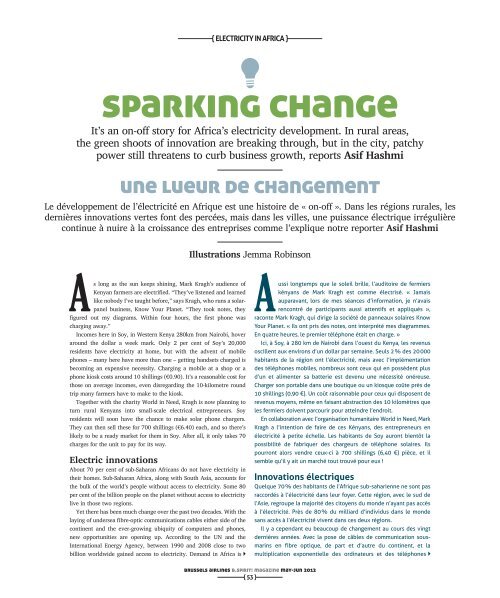may-2012
may-2012
may-2012
You also want an ePaper? Increase the reach of your titles
YUMPU automatically turns print PDFs into web optimized ePapers that Google loves.
{ ELECTRICITY IN AFRICA }<br />
sparking change<br />
It’s an on-off story for Africa’s electricity development. In rural areas,<br />
the green shoots of innovation are breaking through, but in the city, patchy<br />
power still threatens to curb business growth, reports Asif Hashmi<br />
une lueur de changement<br />
Le développement de l’électricité en Afrique est une histoire de « on-off ». Dans les régions rurales, les<br />
dernières innovations vertes font des percées, mais dans les villes, une puissance électrique irrégulière<br />
continue à nuire à la croissance des entreprises comme l’explique notre reporter Asif Hashmi<br />
s long as the sun keeps shining, Mark Kragh’s audience of<br />
Kenyan farmers are electrified. “They’ve listened and learned<br />
like nobody I’ve taught before,” says Kragh, who runs a solarpanel<br />
business, Know Your Planet. “They took notes, they<br />
figured out my diagrams. Within four hours, the first phone was<br />
charging away.”<br />
Incomes here in Soy, in Western Kenya 280km from Nairobi, hover<br />
around the dollar a week mark. Only 2 per cent of Soy’s 20,000<br />
residents have electricity at home, but with the advent of mobile<br />
phones – many here have more than one – getting handsets charged is<br />
becoming an expensive necessity. Charging a mobile at a shop or a<br />
phone kiosk costs around 10 shillings (€0.90). It’s a reasonable cost for<br />
those on average incomes, even disregarding the 10-kilometre round<br />
trip many farmers have to make to the kiosk.<br />
Together with the charity World in Need, Kragh is now planning to<br />
turn rural Kenyans into small-scale electrical entrepreneurs. Soy<br />
residents will soon have the chance to make solar phone chargers.<br />
They can then sell these for 700 shillings (€6.40) each, and so there’s<br />
likely to be a ready market for them in Soy. After all, it only takes 70<br />
charges for the unit to pay for its way.<br />
Electric innovations<br />
About 70 per cent of sub-Saharan Africans do not have electricity in<br />
their homes. Sub-Saharan Africa, along with South Asia, accounts for<br />
the bulk of the world’s people without access to electricity. Some 80<br />
per cent of the billion people on the planet without access to electricity<br />
live in those two regions.<br />
Yet there has been much change over the past two decades. With the<br />
laying of undersea fibre-optic communications cables either side of the<br />
continent and the ever-growing ubiquity of computers and phones,<br />
new opportunities are opening up. According to the UN and the<br />
International Energy Agency, between 1990 and 2008 close to two<br />
billion worldwide gained access to electricity. Demand in Africa is<br />
Illustrations Jemma Robinson<br />
A A<br />
brussels airlines b.spirit! magazine <strong>may</strong>-jun <br />
{ 53 }<br />
ussi longtemps que le soleil brille, l’auditoire de fermiers<br />
kényans de Mark Kragh est comme électrisé. « Jamais<br />
auparavant, lors de mes séances d’information, je n’avais<br />
rencontré de participants aussi attentifs et appliqués »,<br />
raconte Mark Kragh, qui dirige la société de panneaux solaires Know<br />
Your Planet. « Ils ont pris des notes, ont interprété mes diagrammes.<br />
En quatre heures, le premier téléphone était en charge. »<br />
Ici, à Soy, à 280 km de Nairobi dans l’ouest du Kenya, les revenus<br />
oscillent aux environs d’un dollar par semaine. Seuls 2 % des 20 000<br />
habitants de la région ont l’électricité, mais avec l’implémentation<br />
des téléphones mobiles, nombreux sont ceux qui en possèdent plus<br />
d’un et alimenter sa batterie est devenu une nécessité onéreuse.<br />
Charger son portable dans une boutique ou un kiosque coûte près de<br />
10 shillings (0,90 €). Un coût raisonnable pour ceux qui disposent de<br />
revenus moyens, même en faisant abstraction des 10 kilomètres que<br />
les fermiers doivent parcourir pour atteindre l’endroit.<br />
En collaboration avec l’organisation humanitaire World in Need, Mark<br />
Kragh a l’intention de faire de ces Kényans, des entrepreneurs en<br />
électricité à petite échelle. Les habitants de Soy auront bientôt la<br />
possibilité de fabriquer des chargeurs de téléphone solaires. Ils<br />
pourront alors vendre ceux-ci à 700 shillings (6,40 €) pièce, et il<br />
semble qu’il y ait un marché tout trouvé pour eux !<br />
Innovations électriques<br />
Quelque 70 % des habitants de l’Afrique sub-saharienne ne sont pas<br />
raccordés à l’électricité dans leur foyer. Cette région, avec le sud de<br />
l’Asie, regroupe la majorité des citoyens du monde n’ayant pas accès<br />
à l’électricité. Près de 80 % du milliard d’individus dans le monde<br />
sans accès à l’électricité vivent dans ces deux régions.<br />
Il y a cependant eu beaucoup de changement au cours des vingt<br />
dernières années. Avec la pose de câbles de communication sousmarins<br />
en fibre optique, de part et d’autre du continent, et la<br />
multiplication exponentielle des ordinateurs et des téléphones











